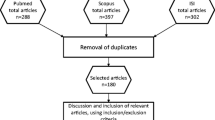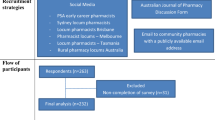Abstract
Purpose
The purpose of this study was to explore the knowledge, attitudes and practices of health professionals working in clinical trials, to pharmacovigilance and adverse drug reaction (ADR) reporting.
Methods
A mixed methods study comprising an online questionnaire disseminated from September to November 2018, three semi-structured interviews and four focus groups. The qualitative components were conducted with a random sample of questionnaire participants who had provided their contact details (n = 24). The qualitative interviews were conducted at a location convenient to the participant’s place of work between October and December 2018.
Results
One hundred forty-eight participants completed the questionnaire. Study coordinators/project managers represented the largest group of participants ( 28.6%, n = 38). Poor knowledge or understanding of ADR reporting was the most frequently cited barrier to ADR reporting (75%, n = 93). The most common enabler to reporting was having a clear understanding of an ADR definition (85.7%, n = 108). Focus group and interview participants described having limited staff as a barrier to reporting an ADR. They welcomed the prospect of pharmacovigilance training and indicated that face-to-face training would be preferred to provision of online training.
Conclusion
This study highlights key factors that influence the reporting of ADRs in clinical trials. Although the findings are specifically related to the clinical trial environment in Ireland, they may provide a useful platform for optimising the future conduct of trials. This research suggests that ADR reporting may be improved through provision of enhanced pharmacovigilance training to clinical trial staff.

Similar content being viewed by others
References
Organization WH (2002) The importance of pharmacovigilance: safety monitoring of medicinal products. WHO Collaborating Centre for International Drug Monitoring
Organization WH (2002) Safety of medicines: a guide to detecting and reporting adverse drug reactions: why health professionals need to take action. World Health Organization, Geneva
Organisation WH Pharmacovigilance. https://www.whoint/medicines/areas/quality_safety/safety_efficacy/pharmvigi/en/. Accessed December 2018
Backstrom M, Ekman E, Mjorndal T (2007) Adverse drug reaction reporting by nurses in Sweden. Eur J Clin Pharmacol 63(6):613–618. https://doi.org/10.1007/s00228-007-0274-8
European Commission. MEMO/08/782 B (2008) Strengthening pharmacovigilance to reduce adverse effects of medicines. Accessed December 2018
Lopes P, Nunes T, Campos D, Furlong LI, Bauer-Mehren A, Sanz F, Carrascosa MC, Mestres J, Kors J, Singh B, van Mulligen E, Van der Lei J, Diallo G, Avillach P, Ahlberg E, Boyer S, Diaz C, Oliveira JL (2013) Gathering and exploring scientific knowledge in pharmacovigilance. PLoS One 8(12):e83016. https://doi.org/10.1371/journal.pone.0083016
Martin K, Begaud B, Latry P, Miremont-Salame G, Fourrier A, Moore N (2004) Differences between clinical trials and postmarketing use. Br J Clin Pharmacol 57(1):86–92
Edwards JE, McQuay HJ, Moore RA, Collins SL (1999) Reporting of adverse effects in clinical trials should be improved: lessons from acute postoperative pain. J Pain Symptom Manag 18(6):427–437
Ioannidis JP, Lau J (2001) Completeness of safety reporting in randomized trials: an evaluation of 7 medical areas. JAMA 285(4):437–443
Union E (2005) Good clinical practice directive (Directive 2005/28/EC of 8 April 2005 of the European Parliament and of the Council). Off J Eur Union 1–7
Krumholz HM, Ross JS, Presler AH, Egilman DS (2007) What have we learnt from Vioxx? Bmj 334(7585):120–123. https://doi.org/10.1136/bmj.39024.487720.68
Cohen D (2010) Rosiglitazone: what went wrong? Bmj 341:c4848. https://doi.org/10.1136/bmj.c4848
Hammad TA, Pinheiro SP, Neyarapally GA (2011) Secondary use of randomized controlled trials to evaluate drug safety: a review of methodological considerations. Clin Trials 8(5):559–570. https://doi.org/10.1177/1740774511419165
Hollis S, Fletcher C, Lynn F, Urban HJ, Branson J, Burger HU, Tudur Smith C, Sydes MR, Gerlinger C (2016) Best practice for analysis of shared clinical trial data. BMC Med Res Methodol 16(Suppl 1):76. https://doi.org/10.1186/s12874-016-0170-y
Loke YK, Derry S (2001) Reporting of adverse drug reactions in randomised controlled trials-a systematic survey. BMC Clin Pharmacol 1:3
Creswell JW, Plano Clark VL (2011) Designing and conducting mixed methods research. Sage https://books.google.ie/books/about/Designing_and_Conducting_Mixed_Methods_R.html?id=YcdlPWPJRBcC
McGee D, Lorencatto F, Matvienko-Sikar K, Toomey E (2018) Surveying knowledge, practice and attitudes towards intervention fidelity within trials of complex healthcare interventions. Trials 19(1):504. https://doi.org/10.1186/s13063-018-2838-6
O'Callaghan J, Griffin BT, Morris JM, Bermingham M (2018) Knowledge of adverse drug reaction reporting and the pharmacovigilance of biological medicines: a survey of healthcare professionals in Ireland. BioDrugs Clin Immunother Biopharm Gene Ther 32(3):267–280. https://doi.org/10.1007/s40259-018-0281-6
Braun V, Clarke V (2006) Using thematic analysis in psychology. Qual Res Psychol 3(2):77–101
Cameron RADT, Richardson S, Ahmed E, Sukumaran A (2013) Lessons from the field: applying the good reporting of a mixed methods study (GRAMMS) framework. Electron J Bus Res Methods 11(2):53–64
Alshammari TM, Alamri KK, Ghawa YA, Alohali NF, Abualkol SA, Aljadhey HS (2015) Knowledge and attitude of health-care professionals in hospitals towards pharmacovigilance in Saudi Arabia. Int J Clin Pharm 37(6):1104–1110. https://doi.org/10.1007/s11096-015-0165-5
Li Q, Zhang SM, Chen HT, Fang SP, Yu X, Liu D, Shi LY, Zeng FD (2004) Awareness and attitudes of healthcare professionals in Wuhan, China to the reporting of adverse drug reactions. Chin Med J 117(6):856–861
George GC, Barata PC, Campbell A, Chen A, Cortes JE, Hyman DM, Jones L, Karagiannis T, Klaar S, Le-Rademacher JG, LoRusso P, Mandrekar SJ, Merino DM, Minasian LM, Mitchell SA, Montez S, O'Connor DJ, Pettit S, Silk E, Sloan JA, Stewart M, Takimoto CH, Wong GY, Yap TA, Cleeland CS, Hong DS (2019) Improving attribution of adverse events in oncology clinical trials. Cancer Treat Rev 76:33–40. https://doi.org/10.1016/j.ctrv.2019.04.004
Wutoh R, Boren SA, Balas EA (2004) eLearning: a review of Internet-based continuing medical education. J Contin Educ Heal Prof 24(1):20–30. https://doi.org/10.1002/chp.1340240105
Pietanza MC, Basch EM, Lash A, Schwartz LH, Ginsberg MS, Zhao B, Shouery M, Shaw M, Rogak LJ, Wilson M, Gabow A, Latif M, Lin KH, Wu Q, Kass SL, Miller CP, Tyson L, Sumner DK, Berkowitz-Hergianto A, Sima CS, Kris MG (2013) Harnessing technology to improve clinical trials: study of real-time informatics to collect data, toxicities, image response assessments, and patient-reported outcomes in a phase II clinical trial. J Clin Oncol Off J Am Soc Clin Oncol 31(16):2004–2009. https://doi.org/10.1200/jco.2012.45.8117
Perez RP, Finnigan S, Patel K, Whitney S, Forrest A (2016) Clinical trial electronic portals for expedited safety reporting: recommendations from the Clinical Trials Transformation Initiative Investigational New Drug Safety Advancement Project. JMIR Cancer 2(2):e16. https://doi.org/10.2196/cancer.6701
Mirbaha F, Shalviri G, Yazdizadeh B, Gholami K, Majdzadeh R (2015) Perceived barriers to reporting adverse drug events in hospitals: a qualitative study using theoretical domains framework approach. Implement Sci 10:110. https://doi.org/10.1186/s13012-015-0302-5
Baer AR, Devine S, Beardmore CD, Catalano R (2011) Clinical investigator responsibilities. J Oncol Pract 7(2):124
Agency EM (2016) ICH E6 (R2) Guideline for good clinical practice
Ross JS (2010) The role of the subinvestigator. Monitor:84–85
Seruga B, Templeton AJ, Badillo FE, Ocana A, Amir E, Tannock IF (2016) Under-reporting of harm in clinical trials. Lancet Oncol 17(5):e209–e219. https://doi.org/10.1016/s1470-2045(16)00152-2
Basch E, Bennett A, Pietanza MC (2011) Use of patient-reported outcomes to improve the predictive accuracy of clinician-reported adverse events. J Natl Cancer Inst 103(24):1808–1810. https://doi.org/10.1093/jnci/djr493
van Eekeren R, Rolfes L, Koster AS, Magro L, Parthasarathi G, Al Ramimmy H, Schutte T, Tanaka D, van Puijenbroek E, Harmark L (2018) What future healthcare professionals need to know about pharmacovigilance: introduction of the WHO PV core curriculum for university teaching with focus on clinical aspects. Drug Saf. https://doi.org/10.1007/s40264-018-0681-z
Beckmann J, Hagemann U, Bahri P, Bate A, Boyd IW, Dal Pan GJ, Edwards BD, Edwards IR, Hartigan-Go K, Lindquist M, McEwen J, Moride Y, Olsson S, Pal SN, Soulaymani-Bencheikh R, Tuccori M, Vaca CP, Wong IC (2014) Teaching pharmacovigilance: the WHO-ISoP core elements of a comprehensive modular curriculum. Drug Saf 37(10):743–759. https://doi.org/10.1007/s40264-014-0216-1
Rosebraugh CJ, Tsong Y, Zhou F, Chen M, Mackey AC, Flowers C, Toyer D, Flockhart DA, Honig PK (2003) Improving the quality of adverse drug reaction reporting by 4th-year medical students. Pharmacoepidemiol Drug Saf 12(2):97–101. https://doi.org/10.1002/pds.797
Hartman J, Harmark L, van Puijenbroek E (2017) A global view of undergraduate education in pharmacovigilance. Eur J Clin Pharmacol 73(7):891–899. https://doi.org/10.1007/s00228-017-2237-z
Arici MA, Gelal A, Demiral Y, Tuncok Y (2015) Short and long-term impact of pharmacovigilance training on the pharmacovigilance knowledge of medical students. Indian J Pharm 47(4):436–439. https://doi.org/10.4103/0253-7613.161272
Acknowledgements
The authors would like to thank all clinical trial personnel who participated in the study, in particular, the following groups who provided access to their network: Health Research Board (HRB) Clinical Research Coordination Ireland (CRCI), HRB Irish Critical Care Clinical Trials Network, HRB Primary Care Clinical Trials Network Ireland, Qualitative Research in Trials Centre (QUESTS), Cancer Trials Ireland, HRB Stroke Clinical Trials Network Ireland, The Pharmaceutical Society of Ireland, Irish Research Nurses Network (IRNN), HRB Trials Methodology Research Network (TMRN), HRB Clinical Research Facility Cork, Tallaght University Hospital Dublin, St James’s Hospital Dublin, Royal College of Surgeons in Ireland (RCSI), HRB Clinical Research Facility Galway, University College Dublin Clinical Research Centre (UCD CRC), Cancer Clinical Trials Unit, Children’s Health Ireland Crumlin, Children’s Clinical Research Unit, National Children’s Research Centre, Centre for Advanced Medical Imaging (CAMI), and Irish Centre for Foetal and Neonatal Translational Research (INFANT).
Funding
This research was funded by the Health Research Board, Ireland.
Author information
Authors and Affiliations
Contributions
All authors contributed to the study conception and design. Material preparation, data collection and analysis were performed by David O Riordan, Mary Kinane, Kieran A. Walsh, Frances Shiely, Joe Eustace and Margaret Bermingham. The first draft of the manuscript was written by David O Riordan, and all authors commented on previous versions of the manuscript. All authors read and approved the final manuscript.
Corresponding author
Ethics declarations
Ethical approval was required for this study as it involved human subjects.
Informed consent
Informed consent was obtained from all individual participants included in the study.
Additional information
Publisher’s note
Springer Nature remains neutral with regard to jurisdictional claims in published maps and institutional affiliations.
Electronic supplementary material
ESM 1
(DOCX 77 kb)
Rights and permissions
About this article
Cite this article
Riordan, D.O., Kinane, M., Walsh, K.A. et al. Stakeholders’ knowledge, attitudes and practices to pharmacovigilance and adverse drug reaction reporting in clinical trials: a mixed methods study. Eur J Clin Pharmacol 76, 1363–1372 (2020). https://doi.org/10.1007/s00228-020-02921-0
Received:
Accepted:
Published:
Issue Date:
DOI: https://doi.org/10.1007/s00228-020-02921-0




